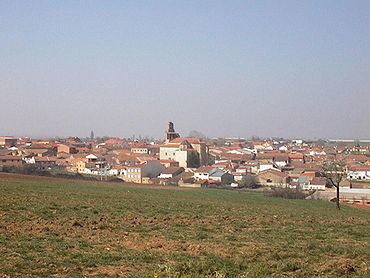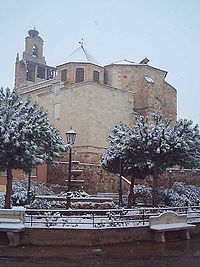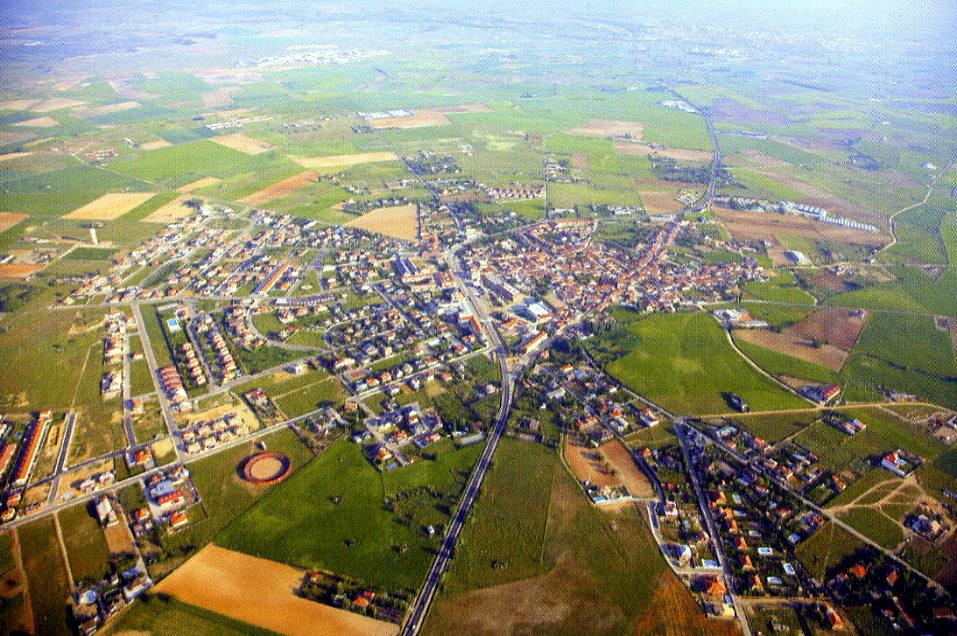
Morales del Vino
Encyclopedia
Morales del Vino is a municipality located in the province of Zamora
, Castile and León
, Spain
. According to the 2007 census
(INE
), the municipality has a population of 2,345 inhabitants.

, 56 km to the South, and 100 km to Valladolid
. Not too far is Portugal
, 60 km.
The landscape is mainly flat, with no hills around. The village is surrounded by a continental cereal, legume and sunflower farm land, with some irrigated areas close to the river where maize, sugarbeet and sunflowers are also cropped. There are not large forests around, although some scattered trees in the fields can be found in the rainfed land or some other riverside forests are near the Duero. In the area of the municipality you can find the 'Soto de Pontejos' poplar forests, with wild asparagus plants growing under the trees and among other thorny shrubs.
As the province of Zamora is located in the Northern Plateau of Spain
, Morales has a Mediterranean-Continental climate. The main traits are the cold winters (-12°C) and the hot summers (40°C) and a long dry and sunny period around the summer only interrupted by some thunderstorms and some frequent rain in Spring and Autumn mainly. Some snow can happen in the winter but the most frequent phenomenon during winter is the fog that stays in the Duero valley producing very cold days (0°C during the day, -5°C during the night) with no sunshine for periods longer than one week. Apart from those days, sunshine in Morales is the predominant phenomenon.
, are about to finish.
There are many new buildings in Morales del Vino due to the new population living there, and there are many new businesses and services in the village nowadays. Some of the new houses in the town are apartments but most of them are cottages or single houses with their own swimming pool and beautiful gardens. You can find in the town centre some shops and supermarkets, several bank branches, a petrol station, a chemist shop, several bars, press and lottery, fast food and some nice restaurants.
The main economic resource of Morales used to be farming, either cattle, sheep, pig or grassland farming. Nowadays, the village is bigger due to the people from Zamora who live in it because of the more tranquil environment, the lower property values, and the commodities available in Morales. There are many people employed now in bars, industry, offices and other services, but even now one finds a beautiful rural landscape around the village.
Many areas of Northwest of Spain are famous for the food. Morales del Vino is placed within some quality of origin demarcation for food, as the Zamorano Cheese, Zamorano Chorizo and Tierra del Vino Wine. Cheese and wine are the most representative products from these region and Morales holds two high quality cheese factories that can be visited. These factories produce cheese from the local sheep and cow milk. Visitors shouldn't leave Morales without tasting these local products. These products are essential in the daily diet of many 'moralinos', as the pulses and vegetables are too.

There is also a little church on the road to Zamora, called El Cristo, where every May the 9th, the people from Morales, Zamora and other surrounding areas celebrate the Morales del Vino main festivity, El Cristo de Morales, a typical "romería" where one may taste very good "sangría", some of the best typical tapas and have a lot of fun in the attractions and in the bars, located in a yard close to the church, where is located the Christ, from the Middle Ages. In this festivity music plays an important role, and because the weather is not usually bad, young and old people celebrate the whole day in the yard drinking 'sangria' and tasting the tapas while the devotes visit the church and attend to the workshops.
Morales has many old houses built next to each other, with the main fachade on the street and a backyard used typically to grow a little kitchen garden and some hens, pigs or rabbits. A typical old style house might also have several stables to keep the donkeys, mules or horses used in those days to plow the soil or as the only transport means. Nowadays some of these old houses have been restored and they are considered to be luxury mansions. Many of them also have a cave several meters underneath them, where wine was fermented and aged. The old town of Morales is mined with many caves, some of which are beautifully restored as party lounges now. If the visitor get the chance to visit the Town Hall, which was a big house transformed decades ago to the town school (in the 1940s) made on the typical sandstone used in the old style buildings, it would be worth to ask someone in the offices to access to the Town Hall Cave. It is now used only in a few celebrations.
 To visit Morales del Vino, there are several ways to reach it; the main way is the road N-630 (Km 285), but there is also a nearby train station in Zamora, with routes to Galicia, Madrid
To visit Morales del Vino, there are several ways to reach it; the main way is the road N-630 (Km 285), but there is also a nearby train station in Zamora, with routes to Galicia, Madrid
and Valladolid
. The closest airports are in Valladolid
, Salamanca
, Bragança
and León
, but also Madrid
is not too far (250 km).
Zamora (province)
Zamora is a Spanish province of western Spain, in the western part of the autonomous community of Castile and León.The present-day province of Zamora province was one of three provinces formed from the former Kingdom of León in 1833, when Spain was re-organised into 49 provinces.It is bordered by...
, Castile and León
Castile and León
Castile and León is an autonomous community in north-western Spain. It was so constituted in 1983 and it comprises the historical regions of León and Old Castile...
, Spain
Spain
Spain , officially the Kingdom of Spain languages]] under the European Charter for Regional or Minority Languages. In each of these, Spain's official name is as follows:;;;;;;), is a country and member state of the European Union located in southwestern Europe on the Iberian Peninsula...
. According to the 2007 census
Census
A census is the procedure of systematically acquiring and recording information about the members of a given population. It is a regularly occurring and official count of a particular population. The term is used mostly in connection with national population and housing censuses; other common...
(INE
Instituto Nacional de Estadística (Spain)
The National Institute of Statistics is the official organisation in Spain that collects statistics about demography, economy, and Spanish society. Every 10 years, this organisation conducts a national census. The last census took place in 2001....
), the municipality has a population of 2,345 inhabitants.

Geography and climate
It is located near the river Duero, 5 km South of Zamora, in the Northern Plateau (700 m above sea level) of the Iberian Peninsula. Other cities that are near Morales del Vino are SalamancaSalamanca
Salamanca is a city in western Spain, in the community of Castile and León. Because it is known for its beautiful buildings and urban environment, the Old City was declared a UNESCO World Heritage Site in 1988. It is the most important university city in Spain and is known for its contributions to...
, 56 km to the South, and 100 km to Valladolid
Valladolid
Valladolid is a historic city and municipality in north-central Spain, situated at the confluence of the Pisuerga and Esgueva rivers, and located within three wine-making regions: Ribera del Duero, Rueda and Cigales...
. Not too far is Portugal
Portugal
Portugal , officially the Portuguese Republic is a country situated in southwestern Europe on the Iberian Peninsula. Portugal is the westernmost country of Europe, and is bordered by the Atlantic Ocean to the West and South and by Spain to the North and East. The Atlantic archipelagos of the...
, 60 km.
The landscape is mainly flat, with no hills around. The village is surrounded by a continental cereal, legume and sunflower farm land, with some irrigated areas close to the river where maize, sugarbeet and sunflowers are also cropped. There are not large forests around, although some scattered trees in the fields can be found in the rainfed land or some other riverside forests are near the Duero. In the area of the municipality you can find the 'Soto de Pontejos' poplar forests, with wild asparagus plants growing under the trees and among other thorny shrubs.
As the province of Zamora is located in the Northern Plateau of Spain
Spain
Spain , officially the Kingdom of Spain languages]] under the European Charter for Regional or Minority Languages. In each of these, Spain's official name is as follows:;;;;;;), is a country and member state of the European Union located in southwestern Europe on the Iberian Peninsula...
, Morales has a Mediterranean-Continental climate. The main traits are the cold winters (-12°C) and the hot summers (40°C) and a long dry and sunny period around the summer only interrupted by some thunderstorms and some frequent rain in Spring and Autumn mainly. Some snow can happen in the winter but the most frequent phenomenon during winter is the fog that stays in the Duero valley producing very cold days (0°C during the day, -5°C during the night) with no sunshine for periods longer than one week. Apart from those days, sunshine in Morales is the predominant phenomenon.
Etymology
The translation into English of the town name is 'Mulberry trees of the Wine', with no sense, but the fact that Morales is located in the Tierra del Vino (Wine Shire) gives the 'surname' of the village and the mulberry trees are not unusual in this territory. Tierra del Vino used to be known for its massive production of wine and the wide vineyards around. Decades ago vine diseases made them to nearly absolutely disappear but nowadays new agricultural techniques and the Quality Brand of the Tierra del Vino Wine have increased the amount of vineyards and the cellars that make the typically red wine from Tempranillo variety.Population and social facts
Morales population was over 2400 people at the beginning of 2007, but it has quickly increased recently due to its location close to Zamora, the capital of the province, and the good communication of the N-630 Ruta de la Plata road, that crosses the West of Spain, from Asturias to Andalucía. The roadworks that will end up with a new motorway, the A-66Autovía A-66
The Autovía A-66 is a major highway in western Spain. It also forms part of the European Route E803. The road is an upgrade of the N-630 which is being undertaken section by section. The route roughly corresponds to the ancient Roman 'Silver Route' from the mines of northern Spain to the...
, are about to finish.
There are many new buildings in Morales del Vino due to the new population living there, and there are many new businesses and services in the village nowadays. Some of the new houses in the town are apartments but most of them are cottages or single houses with their own swimming pool and beautiful gardens. You can find in the town centre some shops and supermarkets, several bank branches, a petrol station, a chemist shop, several bars, press and lottery, fast food and some nice restaurants.
The main economic resource of Morales used to be farming, either cattle, sheep, pig or grassland farming. Nowadays, the village is bigger due to the people from Zamora who live in it because of the more tranquil environment, the lower property values, and the commodities available in Morales. There are many people employed now in bars, industry, offices and other services, but even now one finds a beautiful rural landscape around the village.
Many areas of Northwest of Spain are famous for the food. Morales del Vino is placed within some quality of origin demarcation for food, as the Zamorano Cheese, Zamorano Chorizo and Tierra del Vino Wine. Cheese and wine are the most representative products from these region and Morales holds two high quality cheese factories that can be visited. These factories produce cheese from the local sheep and cow milk. Visitors shouldn't leave Morales without tasting these local products. These products are essential in the daily diet of many 'moralinos', as the pulses and vegetables are too.

History, Monuments and Visitor attractions
The town was founded in the Middle Ages, when the church was built after the Christians recovered the land from the Moors, who stayed here several centuries, but no ruins are left now of their culture. The church has Gothic and Renaissance art style sculpture and building elements; especially noteworthy are the main chapter and the north entrance, with an unusual style for this area. It holds a magnificent baroque organ that scarcely played in religious celebrations that it is worth to listen.There is also a little church on the road to Zamora, called El Cristo, where every May the 9th, the people from Morales, Zamora and other surrounding areas celebrate the Morales del Vino main festivity, El Cristo de Morales, a typical "romería" where one may taste very good "sangría", some of the best typical tapas and have a lot of fun in the attractions and in the bars, located in a yard close to the church, where is located the Christ, from the Middle Ages. In this festivity music plays an important role, and because the weather is not usually bad, young and old people celebrate the whole day in the yard drinking 'sangria' and tasting the tapas while the devotes visit the church and attend to the workshops.
Morales has many old houses built next to each other, with the main fachade on the street and a backyard used typically to grow a little kitchen garden and some hens, pigs or rabbits. A typical old style house might also have several stables to keep the donkeys, mules or horses used in those days to plow the soil or as the only transport means. Nowadays some of these old houses have been restored and they are considered to be luxury mansions. Many of them also have a cave several meters underneath them, where wine was fermented and aged. The old town of Morales is mined with many caves, some of which are beautifully restored as party lounges now. If the visitor get the chance to visit the Town Hall, which was a big house transformed decades ago to the town school (in the 1940s) made on the typical sandstone used in the old style buildings, it would be worth to ask someone in the offices to access to the Town Hall Cave. It is now used only in a few celebrations.

Madrid
Madrid is the capital and largest city of Spain. The population of the city is roughly 3.3 million and the entire population of the Madrid metropolitan area is calculated to be 6.271 million. It is the third largest city in the European Union, after London and Berlin, and its metropolitan...
and Valladolid
Valladolid
Valladolid is a historic city and municipality in north-central Spain, situated at the confluence of the Pisuerga and Esgueva rivers, and located within three wine-making regions: Ribera del Duero, Rueda and Cigales...
. The closest airports are in Valladolid
Valladolid
Valladolid is a historic city and municipality in north-central Spain, situated at the confluence of the Pisuerga and Esgueva rivers, and located within three wine-making regions: Ribera del Duero, Rueda and Cigales...
, Salamanca
Salamanca
Salamanca is a city in western Spain, in the community of Castile and León. Because it is known for its beautiful buildings and urban environment, the Old City was declared a UNESCO World Heritage Site in 1988. It is the most important university city in Spain and is known for its contributions to...
, Bragança
Bragança (Portugal)
Bragança is a city and municipality in north-eastern Portugal, capital of district of Bragança, in Alto Trás-os-Montes subregion of Portugal. In 2001, the population of the municipality was 34,774, in an area of 1173.57 km².-History:...
and León
León, Spain
León is the capital of the province of León in the autonomous community of Castile and León, situated in the northwest of Spain. Its city population of 136,985 makes it the largest municipality in the province, accounting for more than one quarter of the province's population...
, but also Madrid
Madrid
Madrid is the capital and largest city of Spain. The population of the city is roughly 3.3 million and the entire population of the Madrid metropolitan area is calculated to be 6.271 million. It is the third largest city in the European Union, after London and Berlin, and its metropolitan...
is not too far (250 km).

